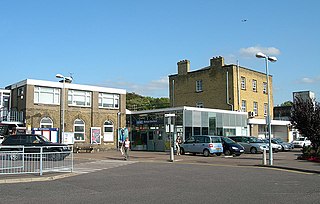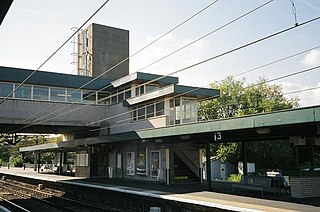
Custom House is a railway station on the Docklands Light Railway (DLR) – on which it is branded Custom House for ExCeL – and on the Elizabeth line, by the Royal Docks, in Custom House in the London Borough of Newham, London, England. It is situated in Travelcard Zone 3. It takes its name from the old Custom House, which formerly stood nearby, and ExCeL London which it serves.

The Great Eastern Main Line is a 114.5-mile (184.3 km) major railway line on the British railway system which connects Liverpool Street station in central London with destinations in east London and the East of England, including Shenfield, Chelmsford, Colchester, Ipswich and Norwich. Its numerous branches also connect the main line to Southminster, Braintree, Sudbury, Harwich and a number of coastal towns including Southend-on-Sea, Clacton-on-Sea, Walton-on-the-Naze and Lowestoft.

Tottenham Hale is a National Rail and London Underground interchange station located in Tottenham Hale in north London, England. On the National Rail network it is on the West Anglia Main Line, 6 miles (9.7 km) from London Liverpool Street, and is served by Greater Anglia and Stansted Express. On the Underground it is on the Victoria line between Blackhorse Road and Seven Sisters. The station is in Travelcard Zone 3.

Northumberland Park railway station is on the Lea Valley line that forms part of the West Anglia Main Line, serving the ward of Northumberland Park in Tottenham, north London. It is 6 miles 73 chains (11.1 km) down the line from London Liverpool Street and is situated between Tottenham Hale and Meridian Water. Its three-letter station code is NUM and it is in Travelcard zone 3. It is one of the stations that can be used to access Tottenham Hotspur Stadium.

The West Anglia Main Line is one of the two main lines that operate out of Liverpool Street. It runs generally north through Cheshunt, Broxbourne, Harlow, Bishop's Stortford and Audley End to Cambridge, with branches between serving Stratford, Hertford and Stansted Airport. The line runs along the boundary between Hertfordshire and Essex for much of its length.

Shenfield railway station is on the Great Eastern Main Line in the East of England, serving the town of Shenfield, Essex. As well as being a key interchange for medium- and long-distance services on the main line, it is also the western terminus of a branch line to Southend Victoria and one of the two eastern termini of the Elizabeth line. It is 20 miles 16 chains (32.51 km) down the line from Liverpool Street and is situated between Brentwood and either Ingatestone on the main line or Billericay on the branch line. Its three-letter station code is SNF.

Bishop's Stortford railway station is on the West Anglia Main Line serving the town of Bishop's Stortford in Hertfordshire, England. It is 30 miles 27 chains (48.8 km) down the line from London Liverpool Street and is situated between Sawbridgeworth and Stansted Mountfitchet stations. Its three-letter station code is BIS.

Harlow Town railway station is on the West Anglia Main Line serving the town of Harlow in Essex, England. It is 22 miles 59 chains (36.6 km) down the line from London Liverpool Street and is situated between Roydon and Harlow Mill stations. Its three-letter station code is HWN.
The Cross London Route Utilisation Strategy (CLRUS) was the second of the route utilisation strategies (RUS) published by Network Rail (NR), in August 2006. It was included in a map published by the Office of Rail Regulation as established in May 2007.
The Freight Route Utilisation Strategy is a Route Utilisation Strategy in the United Kingdom, published by Network Rail in March 2007. It is one of only two which have the perspective of the network as whole. It was included in a map published by the Office of Rail Regulation (ORR) as established in May 2007. As with other RUSs, the Freight RUS took into account a number of responses to a Draft for Consultation, including those from the ORR.
The Scotland Route Utilisation Strategy is a Route Utilisation Strategy, published by Network Rail in March 2007, the third RUS to be published. The railways in Scotland are divided into three strategic routes, namely Route 24, Route 25 (Highlands) and Route 26 together with parts of Route 8 and Route 18. The three strategic routes form the scope of Network Rail's Scotland Route Utilisation Strategy. Separate RUSs for the ECML and WCML encompass the relevant parts of routes 8 and 18. The Edinburgh Crossrail service, which provides a direct route between Stirling, Dunblane and Bathgate in the west to Newcraighall in the east, operates over part of the ECML east of Edinburgh Waverley to Portobello Junction.
The North West Route Utilisation Strategy (NWRUS) is a Route Utilisation Strategy, published by Network Rail in May 2007. It was the fifth RUS to be produced. It was included in a map published by the Office of Rail Regulation as established in May 2007. It was the first of no fewer than 5 RUSs which cover specific routes in the north-west of England; the others are the Lancashire & Cumbria RUS, the Yorkshire & Humber RUS, the Merseyside RUS, and the West Coast Main Line RUS. In particular it "broadly covers the Manchester journey to work area, the City lines into Liverpool Lime Street and routes from Manchester to Kirkby, Southport and Blackpool", corresponding to Network Rail's then Route 20 - North West Urban.
The East Coast Main Line Route Utilisation Strategy (RUS), published by Network Rail in February 2008, was the seventh RUS.
Network Rail's (NR) South London Route Utilisation Strategy (SLRUS), published in March 2008 (SLRUS) was the eighth Route Utilisation Strategy to be produced. By default, RUSs are established by the Office of Rail Regulation (ORR) unless the latter objects within 60 days. The RUS is included in NR's map as established.
Strategic Route 5 - West Anglia was the designation given by Network Rail, from 2004 to 2009, to a grouping of railway lines in the East of England that encompassed the West Anglia Main Line and its various branch lines. The route provided key services to Cambridge and Stansted Airport as well as supporting suburban services in North London and rural services in Cambridgeshire, Norfolk and Suffolk.
Strategic Route 7 - Great Eastern was the designation given by Network Rail, from 2004 to 2009, to a grouping of railway lines in the East of England that encompassed the Great Eastern Main Line and its various branch lines. The route serviced the regional centres of Colchester, Ipswich and Norwich as well as the ports of Felixstowe and Harwich.
Strategic Route 6 - North London Line and Thameside was the designation Network Rail gave to a grouping of railway lines in Greater London and the East of England region that encompassed the London, Tilbury and Southend Line and overground commuter lines within London. The route provided key services to Southend and London suburban areas as well as supporting various freight routes within London.
The Merseyside Route Utilisation Strategy is a Route Utilisation Strategy published by Network Rail in March 2009. It was the eleventh RUS to be produced. By default, RUSs are established by the Office of Rail Regulation (ORR) unless the latter objects within 60 days. The RUS is included in Network Rail's map as established.
The Kent Route Utilisation Strategy (KRUS) is a Route Utilisation Strategy (RUS), published by Network Rail (NR) in January 2010. it was the thirteenth RUS to be completed, not counting the partially completed Network RUS. By default, RUSs are established by the Office of Rail Regulation (ORR) unless the latter objects within 60 days; and the ORR have confirmed no objection to the establishment of the Kent RUS.
The Sussex Route Utilisation Strategy is a Route Utilisation Strategy (RUS), published by Network Rail (NR) in January 2010. It was the fourteenth RUS to be completed, not counting the partially completed Network RUS. By default, RUSs are established by the Office of Rail Regulation (ORR) unless the latter objects within 60 days, and the ORR have confirmed no objection to the establishment of the Sussex RUS.







